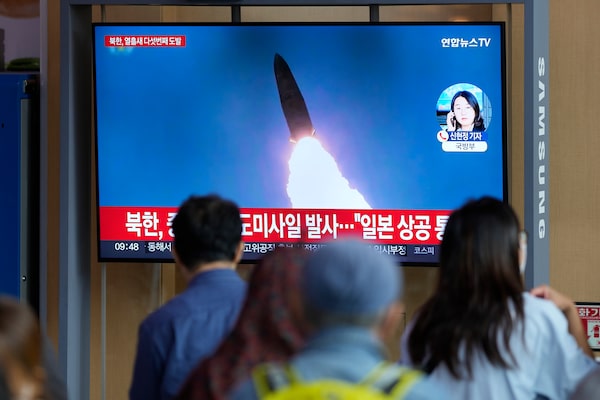
A TV screen showing a news program reporting about North Korea's missile launch with file footage, is seen at the Seoul Railway Station in Seoul, South Korea, Tuesday, Oct. 4, 2022.Lee Jin-man/The Associated Press
Residents in northern Japan were warned to take cover early Tuesday morning as nuclear-armed North Korea fired a missile over the island of Hokkaido and into the Pacific Ocean.
Japanese Prime Minister Fumio Kishida condemned the launch as “barbaric and outrageous” and said he would coordinate a response with allies South Korea and the United States.
Tuesday’s test is the first time North Korea has fired a missile over Japan in five years, and comes after a flurry of recent missile launches by Pyongyang and as South Korea warns another nuclear test may be imminent.
Hirokazu Matsuno, a Japanese government spokesman, said North Korea’s recent actions, including Tuesday’s test, “threaten the peace and security of Japan, the region, and the international community.” He called Pyongyang’s actions a “serious challenge” to Tokyo and its allies.
Defence Minister Yasukazu Hamada said Japan “will continue to examine all options – including so-called ‘counterattack capabilities’ and not rule out anything as we continue to work to fundamentally strengthen our defense abilities.”
Tuesday’s missile flew around 4,000 kilometres, reaching a maximum altitude of 1,000 kilometres, according to the Japanese government. It passed over the strait which separates the northern province of Aomori from Hokkaido, before landing in the Pacific Ocean beyond Japan’s exclusive economic zone.
The South Korean military said it appeared to have been an intermediate-range ballistic missile (IRBM) launched from Jagang Province, on North Korea’s border with China. Pyongyang has used that region to launch several recent tests, including multiple missiles it claimed were “hypersonic.”
Hokkaido resident Sachiko Tachibana said that when her phone began blaring an alert Tuesday, she assumed it was a flood warning, given recent heavy rains. It was not until she turned on the news that she learned what had happened.
“Five years ago we were in a similar situation to today,” Ms. Tachibana said, adding she was “nervous at the time” but had “not been paying much attention” to North Korea recently and was shocked to see another such launch.
Chad O’Carroll, chief executive of the Seoul-based Korea Risk Group, said Pyongyang may be taking advantage of the world’s focus on the war in Ukraine to ramp up missile testing, as well as responding to what North Korea considers “provocations,” such as U.S. Vice President Kamala Harris’ recent trip to the Peninsula and the deployment of U.S. military assets in the region.
“There is a very low risk of any consequence for North Korea from doing this,” he said. While the U.S. and Japan may feel obliged to take some kind of action, this is unlikely to concern Pyongyang, and there is little possibility of concerted international sanctions, given tensions with China and Russia, which have both blocked such action at the United Nations Security Council in the past.
Speaking Tuesday, Daniel Kritenbrink, the top U.S. diplomat for East Asia, described the launch as “unfortunate” and said a path to dialogue remained open. He urged Pyongyang to come back to the table and refrain from further destabilizing actions.
“We are open to diplomacy with North Korea but it very much takes two to tango,” he said. “We are going to leave that door open, but we are going to respond resolutely to this growing threat.”
Following a brief period of diplomacy in 2018-19, which saw North Korean leader Kim Jong Un meet with South Korea’s Moon Jae-in and U.S. President Donald Trump, talks have broken down between Pyongyang and its erstwhile enemies.
During the COVID pandemic, North Korea became more isolated than ever before, and Mr. Kim resumed weapons testing, breaking a 2018 moratorium on intercontinental ballistic missile launches in April with one of its largest weapons ever.
The latest launch was Pyongyang’s fifth in 10 days, amid military muscle-flexing by the United States and South Korea, which conducted trilateral anti-submarine exercises last week with Japanese naval forces.
While previous test have involved “lofted trajectories” that mean the weapons come down not far from where they were launched, firing over or past Japan allows North Korea to test missiles under conditions more akin to “real-world use,” said Ankit Panda of the U.S.-based Carnegie Endowment for International Peace.
“Politically, it’s complicated: the missile largely flies outside of the atmosphere when it’s over Japan, but it’s obviously distressing to the Japanese public to receive warnings of a possible incoming North Korean missile,” he added.
Such launches could be prelude to another nuclear test — North Korea’s seventh. Lawmakers briefed by South Korea’s spy agency said last week Pyongyang had already completed preparations, with the potential window for the test believed to be between October 17 and November 7.
Last month, a defiant Mr. Kim said his country will never abandon its nuclear arsenal, as lawmakers in Pyongyang passed legislation saying atomic weapons could be used when the leadership faced imminent “nuclear or non-nuclear attack by hostile forces.”
“The purpose of the United States is not only to remove our nuclear might itself, but eventually forcing us to surrender or weaken our rights to self-defence through giving up our nukes, so that they could collapse our government at any time,” Mr. Kim said. “Let them sanction us for 100 days, 1,000 days, 10 years or 100 years. We will never give up our rights to self-defence that preserves our country’s existence and the safety of our people.”
Mr. O’Carroll warned that North Korea could use any response to Tuesday’s launch as further “rationale to build up to a nuclear test.” He pointed to Pyongyang’s second test in 2009, which came after a rocket launch which was condemned by the U.N. Security Council.
“They in large part justified that test on the Security Council response,” Mr. O’Carroll said. “The risk now is that they’re trying to artificially generate a point they can be deeply offended by.”
With files from Reuters and the Associated Press
 James Griffiths
James Griffiths